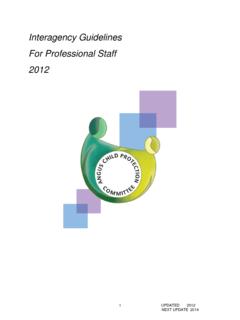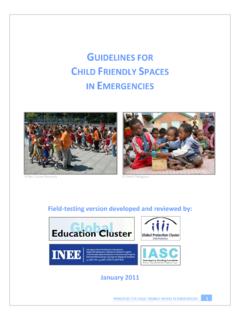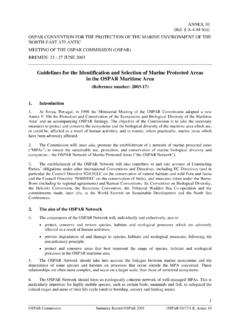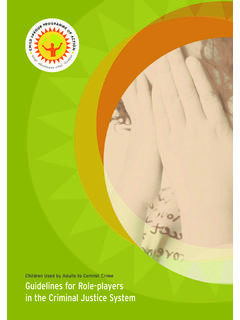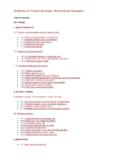Transcription of Civil-military coordination during humanitarian …
1 Civil-military coordination1 during humanitarian health action Provisional version February 2011 Foreword The purpose of this position paper is to guide country-level health clusters on how to apply IASC Civil-military coordination principles to humanitarian health operations. It addresses coordination between civilian humanitarian actors and official, internationally deployed military actors involved in crisis response work. It may also serve to guide humanitarian health actors that are coordinating with national militaries within their own borders and with civil defence and civil protection units. The paper is provisional and intended to serve as the basis for discussions with a wide range of stakeholders including health cluster partners, military representatives, civil defence and civil protection actors, and other humanitarian clusters. It may be used as the basis for similar guidance developed by other clusters. It will be revised to reflect inputs from humanitarian agencies and developments in the area of Civil-military coor-dination.
2 The relation between health humanitarian actors and non-state military groups is outside the scope of this paper. Key messages of this position paper There is a marked difference in the requirements for Civil-military coordination of responses to natural disasters that occur in a peaceful environment and those that occur in the midst of complex emergencies. humanitarian actions should be guided by humanitarian principles and a proper assessment of the impact and evolution of the crisis and the corresponding needs of the population. humanitarian actions should not be used to advance security and/or political agendas. In complex emergencies, military forces and humanitarian actors have different agendas, strategies, tac-tics, mandates and accountability frameworks. 1 The term coordination was chosen instead of other terms such as relation or interaction as it is the term used in IASC-endorsed documents on Civil-military relations.
3 In this framework, coordination is not intended to mean acting together for a common goal, but simply establishing the most appropriate Civil-military relation necessary to fulfil the humanitarian mandate in the specific scenario. Some form of coordination is necessary even to simply coexist. The Global health Cluster, under the leadership of the World health Organization, is made up of more than 30 international humanitarian health organizations that have been working together over the past four years to build partnerships and mutual understanding and to develop common approaches to humanitarian health action. Global health Cluster - Position Paper Civil-military coordination during humanitarian health action 2 Provisional version February 2011 Internationally deployed military forces involved in peace operations or disaster response should provide direct or indirect health assistance to civilians only as a last resort, in the absence of any comparable civilian alternative and to meet the critical needs of the affected population.
4 health services provided by military actors must be in line with the assessed needs of the affected popu-lation. All actors civilian and military involved in the provision of health services should follow the national government s health priorities and plans. In complex emergencies, national health plans must be com-plemented by health information from areas that may not be under the control of the government, as well as by work plans prepared by the international humanitarian community. Humanitarians must constantly review the evolution of the crisis and, when necessary, adapt Civil-military coordination modalities to emerging conflict dynamics and new roles played by the military . Maintaining humanitarian identity is paramount. humanitarian actors should be aware of the perceptions of stakeholders and how different degrees of Civil-military coordination may change local perceptions of their impartiality. Introduction Following natural or man-made disasters, humanitarian health organizations provide life-saving assistance to individuals and communities whose survival is at risk.
5 This is a core component of the humanitarian com-munity s mandate. Under international human rights law,2 health is recognized as a fundamental right of the individual that must be protected in all circumstances. In addition, health is addressed in international hu-manitarian law provisions related to the protection of health facilities and personnel during war. These legal instruments also address the need for belligerents to take the necessary measures to protect and respect medi-cal missions in all The scenarios in which humanitarian health agencies operate are complex in terms of internal dynamics and interactions with external parties involved in the response. Over the last decade, military actors have been increasingly involved in relief activities in various settings, including sometimes providing direct assistance to crisis-affected populations. From a humanitarian perspective, this poses specific questions regarding the extent to which their involvement has a positive impact and, conversely, whether and how this involvement might affect humanitarian organizations ability to respond impartially to the needs of the population.
6 Civil-military coordination problems are particularly relevant for the health sector. health activities have historically been part of counterinsurgency military strategies. More importantly, rehabilitating the health sector is increasingly seen as key to ensuring the country s stability. This document analyses general Civil-military coordination concepts and attempts to provide specific guidance to health actors on Civil-military coordination during crises. The problem humanitarian organizations and military forces have different mandates: humanitarian organizations endeavour to provide life-saving assistance to affected populations based on assessed and documented needs and on the humanitarian principles of humanity, independence and im-partiality. civil defence and civil protection units are usually deployed in a humanitarian crisis on the basis of an agenda of the government to which they belong. As there is no agreed international definition for these categories (see box on civil defence and civil protection below), the different mandates, modes of opera- 2 Article 25(1), Universal Declaration of Human Rights of 1948; Article 12(1), International Covenant on Economic Social and Cultural Rights of 1966.
7 3 For the protection of medical facilities: Art 27, the Hague Convention 1907; Article 19 I Geneva Convention and Article 37 II Geneva Convention 1949. For the protection of medical personnel: Articles 24 and 25 I Geneva Convention, 1949; Art 15 Addi-tional Protocol I to the GC, 1977. Global health Cluster - Position Paper Civil-military coordination during humanitarian health action 3 Provisional version February 2011 tion and natures (civilian or military ) of these actors must be considered when identifying whether and how the humanitarian mechanisms on the ground will engage and coordinate with these actors. Militaries may be present in the context of a humanitarian crisis as combatants, they may have a specific mandate granted by the Security Council (peacekeeping, peace-enforcement or combat), or they may de-ploy internationally at the invitation or with permission of the affected government. military forces may be deployed abroad or inside their own borders.
8 While the specific mandate will differ in different set-tings, it is important to recognize that militaries are deployed with a specific security and political agenda or in support of a security and political agenda. These fundamental differences at the core of the mandates the needs of the population on the one hand and political/security goals on the other guide the respective decision-making processes of humanitarians and the military . This can result in minor differences that still allow for cooperation ( when responding to a natural disaster in a non-conflict setting) or major differences ( those that may occur in combat settings). Any confusion between the different mandates carries the risk that humanitarian aid agencies may be drawn, or perceived to be drawn, into conflict dynamics. humanitarian agencies that are perceived as acting accord-ing to agendas other than their humanitarian mandate may lose their credibility in the eyes of other local ac-tors as well as the trust of the population they are there to serve.
9 This can severely affect their ability to oper-ate and, ultimately, create security risks for their staff and for the aforementioned populations. Identifying a way to engage with the military one that does not dangerously confuse the two mandates is at the core of the Civil-military coordination challenge. civil defence and civil protection While the Additional Protocol I to the Geneva Conventions of 1949 (AP I) lists the tasks that define civil Defence . There is no internationally agreed definition of civil defence or civil protection actors in terms of how they operate, what is their mandate or nature of the relationship with military or security forces of their countries. While in some countries and regions, these terms may have developed distinct meanings; these terms are some-times used interchangeably. This lack of clarity is reflected in the Additional Protocol 1 itself and is replicated in the interagency guidance on Civil-military coordination .
10 While the English version of the AP I and the Oslo Guidelines refer to military and civil defence assets and defines for the purpose of the guidance civil defence as any organization that, under the control of a Government perform the functions enumerated in paragraph 61 of Additional Protocol 1 to the Geneva Conventions of , the French language versions of the AP I and Oslo Guidelines use the term protection civile in the place of civil defence throughout. In the absence of any clear and internationally agreed definition it is critical to recognize that civil defence and civil protection actors are deployed in support of an agenda of the government to which they belong. The way in which humanitarian actors coordinate with civil defence and civil protection actors in a specific setting, de-pends on the specific nature of the civil defence and civil protection actors in that setting. It may be appropriate to include some of these actors in the humanitarian coordination mechanism itself, while in others the approach to coordination may more closely resemble the approach to coordination with military actors.










